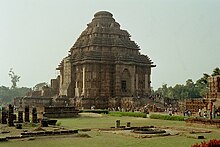Deula

Deula(Odia:ଦେଉଳdeuḷa) is an architectural element in aHindu templein theKalinga architecturestyle of theOdishantemples in Eastern India.[1]Sometimes the whole temple is also referred to asDeula.The word "deula" inOdia languagemeans a building structure built with a particular style that is seen in most of the temples from Odisha.[2]Deulis also used in English, though thedeultemples are also of a different form in theManbhumregion of Western Bengal.
There are three types ofDeulas:[3]In terms of the general north Indian terminology, the Rekha Deula (rekha deul) is the sanctuary and the tower over it, respectively thegarbhagrihaand theshikhara,the Pidha Deula (pida deul) is themandapawhere the faithful are present. The Khakhara deula is an alternative form of tower over the sanctuary, which in shape resembles the oblonggopuramtemple gatehouses in southernDravidian architecture.
Rekha Deula[edit]


Rekha in Odia means a straight line. It is a tall building with a shape of sugar loaf, looking like aShikhara.It covers and protects the sanctum sanctorum (Garbhagriha). Examples:
- TheShikharaof theLingaraja TempleinBhubaneswar
- TheShikharaof theJagannath templeinPuri
- Jagannath TempleinNayagarh
- Uttaresvara Siva TempleinBhubaneswar
- TheShikharaofYameshwar TempleinBhubaneswar
- TheShikharaof the Shantinath Shiva Temple at Shihar village nearJayrambati,Bankura,West Bengal
Pidha Deula[edit]

It is a square building, typically with a pyramid-shaped roof, rather like thevimanatowers over the sanctuaries of temples in southernDravidian architecture.For the halls or service rooms of the temple. Examples
- TheJagamohana(assembly hall) of theSun templeinKonârak
- TheJagamohanaofYameshwara TempleinBhubaneswar
- TheJagamohanaof the Shantinath Shiva Temple in Jayrambati, Bankura, West Bengal
- Digambara Jaina Temple, KhandagiriinBhubaneswar
Khakhara deula[edit]

Khakara deula is a rectangular building with a truncated pyramid-shaped roof, like thegopuras.The name comes from Khakharu (gourd) because of the shape of the roof. The temples of the feminine deities asShaktiare temple of that type. Examples:
- Baitala Deula,Bhubaneswar(dedicated toChamunda)
- Varahi Deula,Chaurasi,Puri district(dedicated toVarahi)
- Brahmi temple,Chaurasi
- Kedara Gouri,Bhubaneswar
- Narayani Temple,Khalikote(dedicated toDurga)
- Durga Temple,Banki
References[edit]
- ^"Architecture on the Indian Subcontinent - Glossary".Retrieved26 January2007.
- ^Fergusson, James (2013). "ORISSA".History of Indian and Eastern Architecture.Cambridge: Cambridge University Press. pp. 92–116.doi:10.1017/cbo9781139814638.007.ISBN9781139814638.
- ^http://orissa.gov.in/e-magazine/Orissareview/nov2005/engpdf/Orissan_Temple_Architecture.pdfp. 45-47
